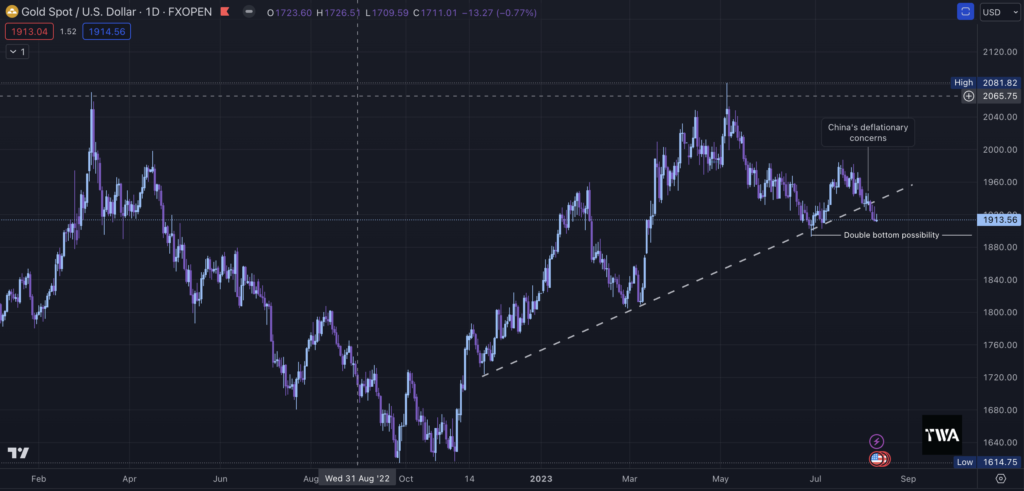Technical Analysis:
In recent weeks, the gold market has been a focal point of attention for investors, as a series of significant events have shaped its trajectory. From breaking trendlines to retracement levels, shifting inflation dynamics to changing interest rate expectations, the gold market’s movements have been closely scrutinized by traders and economists alike.
A recent decline in the gold market was attributed to China’s deflationary concerns, Gold’s price action has been marked by a break of a significant 1-day trendline. This breach has garnered attention from traders, who are now closely monitoring key retracement levels. The 61% retracement level at 1913 stands as critical support, emphasizing the importance of the price range between 1907 and 1895 as a substantial support area. Should the price move beyond this zone, the next level of interest could be around 1858.
The recent release of Consumer Price Index (CPI) figures has introduced an intriguing narrative to the gold market. This environment has kindled speculation about the potential formation of a double bottom pattern on the 1-day chart, indicative of a possible reversal in the price trend.
A broader perspective can be gained by looking at the monthly timeframe, where gold’s price action appears to be predominantly sideways. This suggests that the market is currently grappling with indecision and potential range-bound trading. As market participants await further clarity on key economic indicators, this lateral movement on the monthly chart underscores the significance of patience and a well-informed approach.

Fundamental Analysis:
A broader perspective on the gold market; considering the implications of long-term inflation dynamics and interest rate expectations. The ten-year bond yield, a crucial benchmark, has been influenced by rising inflation concerns, prompting discussions around the need for sustained higher interest rates.
Recent Non-Farm Payroll (NFP) data and the persistently high CPI numbers have led to a recalibration of expectations surrounding the Federal Open Market Committee (FOMC). There is a high probability that there will be no interest rate hike in the upcoming September FOMC meeting has given rise to speculation about a potential shift towards a softer economic landing. Raising the possibility of a rate cut in the November or December, 23 FOMC meetings, signaling a potential shift in monetary policy.
The New York Fed President Sees Interest Rates Coming Down With Inflation

John C. Williams: I think of monetary policy primarily in terms of real interest rates, and we set nominal rates. We’re setting the fed funds target. And assuming inflation continues to come down, it comes down next year, as many forecast, including the economic projections show, then if we don’t cut interest rates at some point next year then real interest rates will go up, and up, and up. And that won’t be consistent with our goals. So I do think that from my perspective, to keep maintaining a restrictive stance may very well involved cutting the federal funds rate next year, or year after, but really it’s about how are we affecting real interest rates — not nominal rates. My outlook is really one where inflation comes back to 2 percent over the next two years, and the economy comes into better balance, and eventually monetary policy will need over the next few years to get back to a more normal — whatever that normal is — a more normal setting of policy. So those all have to kind of come together.
